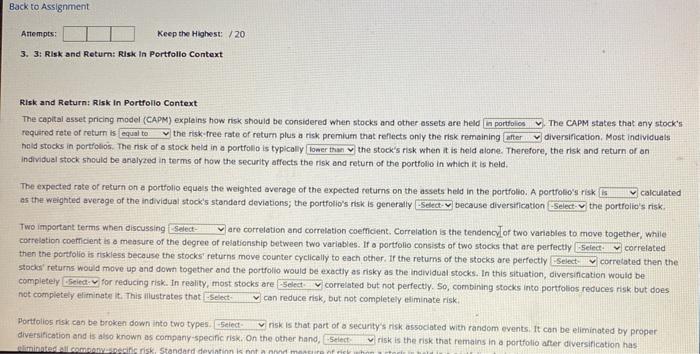
Back to Assignment Attempts: Keep the Highest: /20 3. 3: Risk and Return: Risk In Portfolio Context Risk and Return: Risk In Portfolio Context The capital asset pricing model (CAPM) explains how risk should be considered when stocks and other assets are held in portfolios V The CAPM states that any stock's required rate of return is equal to v the risk free rate of return plus a risk premium that reflects only the risk remaining after v diversification. Most individuals hold stocks in portfolios. The nisk of a stock held in a portfolio is typically lower than the stock's risk when it is held alone. Therefore, the risk and return of on Individual stock should be analyzed in terms of how the security affects the risk and return of the portfolio in which it is held. The expected rate of return on a portfolio equals the weighted average of the expected returns on the assets held in the portfolio. A portfolio's risk is calculated as the weighted average of the individual stock's standard deviations; the portfolio's risk is generally select because diversification Select the portfolio's risk Two important terms when discussing Select- are correlation and correlation coefficient. Correlation is the tendencylor two variables to move together, while correlation coeficient is a measure of the degree of relationship between two variables. If a portfolio consists of two stocks that are perfectly Select correlated then the portfolio is riskless because the stocks' returns move counter cyclically to each other. If the returns of the stocks are perfectly Select correlated then the stock returns would move up and down together and the portfolio would be exactly as risky as the individual stocks. In this situation, diversification would be completely Select-v for reducing risk. In reality, most stocks are -Select correlated but not perfectly. So, combining stocks into portfolios reduces risk but does not completely eliminate it. This illustrates that Select V can reduce risk, but not completely eliminate risk Portfolios risk can be broken down into two types. Select vnk is that part of a security's risk associated with random events. It can be eliminated by proper diversification and is also known as company specific risk. On the other hand, Select risk is the risk that remains in a portfolio atter diversification has limantasis risk. Standard deviation is not and most of the







